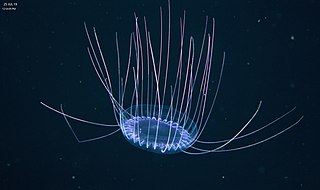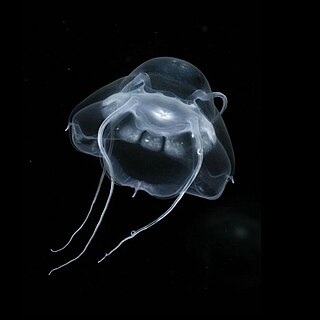
Hydrozoa is a taxonomic class of individually very small, predatory animals, some solitary and some colonial, most of which inhabit saline water. The colonies of the colonial species can be large, and in some cases the specialized individual animals cannot survive outside the colony. A few genera within this class live in freshwater habitats. Hydrozoans are related to jellyfish and corals, which also belong to the phylum Cnidaria.

Solmissus, or dinner plate jellyfish, is a genus of hydrozoans. Its species are unique among cnidarians in that they actively hunt for prey as opposed to passively waiting for plankton to pass by. They are found in the deep waters of Monterey Bay, California. They are most likely to be found in the deep sea, mid water. They grow to be 20 cm (7.9 in) in diameter. These hydrozoans feed on gelatinous zooplankton, including salps and doliolids, ctenophores, jellyfish, and copepods. However, Solmissus may be limited to feeding on soft-bodied prey by the type of nematocysts on their tentacles (Mills).

Leptothecata, or thecate hydroids, are an order of hydrozoans in the phylum Cnidaria. Their closest living relatives are the athecate hydroids, which are similar enough to have always been considered closely related, and the very apomorphic Siphonophorae, which were placed outside the "Hydroida". Given that there are no firm rules for synonymy for high-ranked taxa, alternative names like Leptomedusa, Thecaphora or Thecata, with or without the ending emended to "-ae", are also often used for Leptothecata.

Rhopalonematidae is a family of hydrozoans. The family comprises 15 genera and 36 species.
Lovenellidae is a family of hydrozoans. Their hydroids live together in upright stolonal or sympodial colonies, and their gonophores are pedunculate free-roaming medusae. The relationships of this fairly small but distinctive radiation to other members of the order Leptothecata are not well understood at present.

Narcomedusae is an order of hydrozoans in the subclass Trachylinae. Members of this order do not normally have a polyp stage. The medusa has a dome-shaped bell with thin sides. The tentacles are attached above the lobed margin of the bell with usually a gastric pouch above each. There are no bulbs on the tentacles and no radial canals. Narcomedusans are mostly inhabitants of the open sea and deep waters. They can be found in the Mediterranean in large numbers.
Csiromedusa medeopolis is a species of hydrozoan described in 2010. It was discovered in the estuarine waters of the River Derwent near to the Commonwealth Scientific and Industrial Research Organisation's Marine and Atmospheric Research branch in Hobart, Tasmania, Australia. C. medeopolis has been described as presenting a new family and genus as well as species.

Aequoreidae is a family of hydrozoans, sometimes called the many-ribbed jellies or many-ribbed jellyfish. There are approximately 30 known species found in temperate and tropical marine coastal environments. Aequoreids include Aequorea victoria, the organism from which the green fluorescent protein gene was isolated.

Prayidae is a family of marine invertebrates in the order Siphonophorae. They are colonial, and the colonies can superficially resemble jellyfish; although they appear to be a single organism, each specimen is actually a colony of Siphonophora.

Pandeidae is a family of hydroids in the class Hydrozoa. Like other jellyfish there is usually a mature medusa form which is pelagic and reproduces sexually and a hydroid or polyp form which is often benthic and reproduces asexually by budding.

Aeginidae is a family of hydrozoans in the order Narcomedusae. The family comprises 6 genera and 8 species.

Cuninidae is a family of hydrozoans in the order Narcomedusae. They have dome-shaped bells and tentacles set above the undulating margin of the bell. Their gastric pouches contain the gonads situated in line with the tentacles, the number of pouches being the same as the number of tentacles. The pouches do not extend below the points of origin of the primary tentacles. Members of some genera have a peripheral canal system and others do not. No radial canals or secondary tentacles are present.

Olindiidae is a family of hydrozoans in the order Limnomedusae. They have a polyp phase and a medusa phase. The polyps are generally small (1 mm) and solitary, but a few species are colonial. They have a varying number of tentacles and can reproduce by budding. In the largest species, the medusae can grow to 15 cm (6 in). Centripetal canals may be present or absent and the radial canals are unbranched. The gonads are beside the radial canals, except in Limnocnida, where they are on the manubrium. The fertilised eggs develop into planula larvae which become polyps. These multiply asexually or can bud off medusae. In some species, medusae are only produced when the water temperature exceeds a certain level. Most species are marine, but several can also be found in brackish water and a few, notably Craspedacusta and Limnocnida, are found in fresh water.

Porpita prunella is a marine species of hydrozoan organisms within the family Porpitidae. It consists of colonies of zooids. Very little is known about this species, as there have been no confirmed sightings since its discovery in 1801 and naming by Haeckel in 1888. Being in the chondrophore group, it is likely that its behaviour is similar to the other species of the genera in the family. However there are also serious doubts as to its very existence as a separate species and may in fact be a synonym for Porpita porpita instead.

Filifera is a suborder of hydrozoans in the order Anthoathecata. They are found in marine, brackish and freshwater habitats.

Solmaris is a genus of diminutive hydrozoans.

Aglantha is a genus of deep-sea hydrozoans of the family Rhopalonematidae.
Mitrocomidae is an accepted family in the order Leptothecata.

Rhodaliidae is a family of siphonophores. In Japanese they are called ヒノマルクラゲ.














